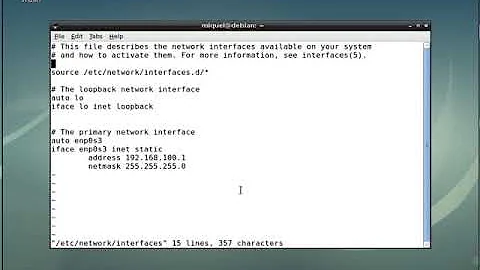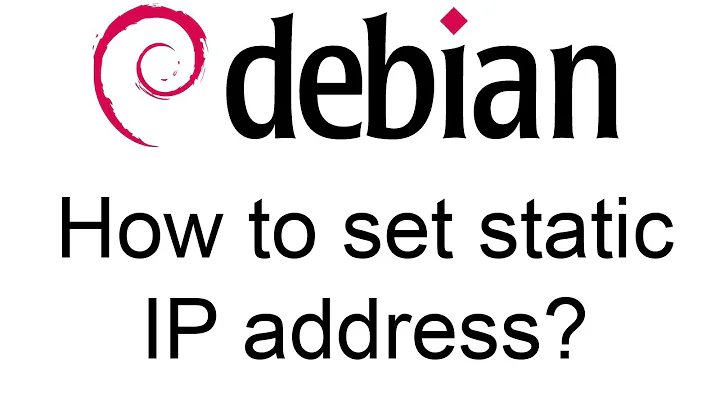Multiple static IP Debian 9 Stretch on one interface
Solution 1
You cannot have multiple default gateway for one interface, and in my opinion the way you are adding multiple IP to the same interface is incorrect.
Add the secondary IP with this notation :
iface enp2s0 inet static
address XX.4.87.10
netmask 255.255.255.224
gateway XX.4.87.1
# route XX.4.87.0/27 via XX.4.87.1
up route add -net XX.4.87.0 netmask 255.255.255.224 gw XX.4.87.1 dev enp2s0
iface enp2s0:1 inet static
address XX.4.87.47
netmask 255.255.255.224
# I removed the "gateway" instruction in this block, as it is a secondary IP
up route add -net XX.4.87.0 netmask 255.255.255.224 gw XX.4.87.33 dev enp2s0
Solution 2
My Debian 9 works like that using the hint from @Marc R.
# This file describes the network interfaces available on your system
# and how to activate them. For more information, see interfaces(5).
source /etc/network/interfaces.d/*
# The loopback network interface
auto lo
iface lo inet loopback
# The primary network interface
allow-hotplug enp0s3
#iface enp0s3 inet dhcp
iface enp0s3 inet static
address 192.168.0.203
netmask 255.255.255.0
gateway 192.168.0.1
iface enp0s3 inet static
address 192.168.0.204
netmask 255.255.255.0
Usually i ever uses eth0:1 or devicename:1 for multi ip now for my surprise at Debian 9 looks like it handles the split by itself.
Related videos on Youtube
Marc R.
Updated on September 18, 2022Comments
-
Marc R. over 1 year
Cannot add multiple IPs to network interface.
While trying to add an IP to the interface enp2s0 via Webmin it says:
Failed to save interface : Missing or invalid interface nameIt's a known bug in Webmin, so lets skip this right now.
Modifying /etc/network/interfaces directly
auto lo iface lo inet loopback iface lo inet6 loopback auto enp2s0 allow-hotplug enp2s0 iface enp2s0 inet static address XX.4.87.10 netmask 255.255.255.224 gateway XX.4.87.1 # route XX.4.87.0/27 via XX.4.87.1 up route add -net XX.4.87.0 netmask 255.255.255.224 gw XX.4.87.1 dev enp2s0 iface enp2s0 inet static address XX.4.87.47 netmask 255.255.255.224 gateway XX.4.87.33 up route add -net XX.4.87.0 netmask 255.255.255.224 gw XX.4.87.33 dev enp2s0 iface enp2s0 inet static address XX.4.87.37 netmask 255.255.255.224 gateway XX.4.87.33 up route add -net XX.4.87.0 netmask 255.255.255.224 gw XX.4.87.33 dev enp2s0 iface enp2s0 inet6 static address XXXX:4f8:140:701e::2 netmask 64 gateway fe80::1The first (main-IP) and the second in the list are always connectable, but the third permanently not. So I'm able to switch the IPs order and can access my server after a reboot, what I'm doing wrong?
(I've also tried the legacy method of Debian Docs but this is crashing it all)
root@hdtu1 ~ # systemctl status networking.service ● networking.service - Raise network interfaces Loaded: loaded (/lib/systemd/system/networking.service; enabled; vendor preset: enabled) Active: failed (Result: exit-code) since Wed 2018-08-01 22:40:12 CEST; 7s ago Docs: man:interfaces(5) Process: 2184 ExecStart=/sbin/ifup -a --read-environment (code=exited, status=1/FAILURE) Process: 2179 ExecStartPre=/bin/sh -c [ "$CONFIGURE_INTERFACES" != "no" ] && [ -n "$(ifquery --read-environment --list --exclude Main PID: 2184 (code=exited, status=1/FAILURE) Aug 01 22:40:12 hdtu1 systemd[1]: Starting Raise network interfaces... Aug 01 22:40:12 hdtu1 ifup[2184]: RTNETLINK answers: File exists Aug 01 22:40:12 hdtu1 ifup[2184]: ifup: failed to bring up enp2s0 Aug 01 22:40:12 hdtu1 systemd[1]: networking.service: Main process exited, code=exited, status=1/FAILURE Aug 01 22:40:12 hdtu1 systemd[1]: Failed to start Raise network interfaces. Aug 01 22:40:12 hdtu1 systemd[1]: networking.service: Unit entered failed state. Aug 01 22:40:12 hdtu1 systemd[1]: networking.service: Failed with result 'exit-code'.-
anders almost 6 yearsExcuse me if I come off about as a noob (because I am).. By why are your gateways the same in the second and third example? Here is an example I use to trick a program to thinking it is talking outside of the LAN so I can redirect it to a local proxy: 'sudo ip addr add 170.33.33.33/32 dev eth0' do /24 for your local LAN. I would check out 'man ip' for the rest of your needed command line options. Hope this helps! If you describe better your needs, I may be able to write an answer. Good luck!
-
Marc R. over 5 yearsThe gateways are given from the housing center. I will have a look for the proxy and will come back to you.
-
mivk over 5 yearsThis Debian wiki section has all the needed info, detailing the various ways to have assign multiple IPs : NetworkConfiguration#Multiple_IP_addresses_on_one_Interface
-
-
Marc R. over 5 yearsA few minutes ago I've exactly reading about that issue you're talking about. The networking service is restarting without trouble now while I'm following your corrections, but the IPs are not connectible after a reboot. Only if i left
auto enp2s0:0andauto enp2s0:1in place the server answers correctly, but the networking service restart fails onExecStart=/sbin/ifup -
Marc R. over 5 yearsUpdate: If I'm removing the gateway and signing both IP XX.4.87.37 && XX.4.87.47 to iface enp2s0:0 it works as expected (why?). After a reboot and a restart of the networking service. No trouble anymore. Thank you!!
-
 Luis Vazquez over 4 yearsThis is the way you added secondary IP address in the 90's and the first decade of the 2000's. It has been more than a decade since the ifconfig command has been deprecated and this kind of "alias" interface configuration with it. With the replacement of the ip tools you should add multiple addresses to the same physical interface, and the ethX:N naming is gone forever.
Luis Vazquez over 4 yearsThis is the way you added secondary IP address in the 90's and the first decade of the 2000's. It has been more than a decade since the ifconfig command has been deprecated and this kind of "alias" interface configuration with it. With the replacement of the ip tools you should add multiple addresses to the same physical interface, and the ethX:N naming is gone forever.




